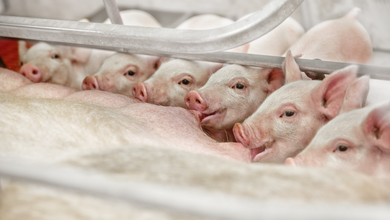
Published on Nov. 9, 2021
The Hypor Libra: demonstrating the importance of reproductive efficiency
How many piglets are your sows weaning per year? That is a common question when considering the productivity of a sow farm. But there are many pieces of the puzzle that make up pigs weaned/ mated female/ year, relating to the reproductive efficiency of the sow.
Each year, we invite our Hypor Libra customers from around the world to participate in a yearly sow productivity benchmark. To present the results from 2020, we will share a series of three articles, each highlighting a different area:
1. Litter Characteristics
2. Reproductive Efficiency and
3. Stayability.
This article covers the reproductive efficiency of the Hypor Libra.
In the table below, several parameters related to reproductive efficiency are summarized from our top Hypor Libra herds around the world.

*productive female calculations do not account for non-productive female days
The benefits of the Hypor Libra
- A logical place to start is the wean to estrus interval. When the Hypor Libra is weaned, she will come into a strong heat, with our top farms seeing 5.4 days on average. Of the sows that are mated, there are few that come back into heat, as demonstrated by 3.2% repeat services. So already, the Hypor Libra efficiently finishes a lactation and starts her next gestation. In turn, 90.8% of the mated sows are farrowing, indicating few irregular returns, abortions, involuntary culls, mortalities, etc. during the gestation period.
- Moving onto an area that is not related to a specific production phase, we can discuss sow deaths and euthanized. This loss of sows is not only increasing across the industry, but we are also facing greater pressure from society for this parameter. However, with the Hypor Libra, she has exceptional survivability, with only 4.8% deaths and euthanized on the top farms. A sow that is able to remain in the herd is better for economic and social sustainability of pig production.
- Non-productive mated female days are another parameter that are not always considered. These are any days where a sow is not gestating or lactating. These days are inevitable (for example, days between weaning and first service), but the goal should be to minimize with improved sow management. For example, a sow that has a regular return to estrus now has an additional 21 non-productive mated female days (NPD).
- The NPD directly influence the calculation of litters/mated female/year (2.48 in top farms) in some regions of the world, but in others they are not incorporated, giving litters/productive female/year (2.56 in top farms). Always be sure to know which calculation is being used before comparing to other farms, countries, etc.
- Whether looking from the basis of productive or mated female, the number of litters per year will also be influenced by farrowing room management. With the Hypor Libra, there is little need for foster sows (these increase lactation length and decreases litters per year), and the milking ability means the piglets reach an appropriate weight, whether weaning at 21 or 28 days (no additional lactation time or milk replacers needed, optimizing litters per year)
- Finally, we approach the pigs weaned/mated female/ year at 32.3 in top farms (incorporates NPD) and pigs weaned/ productive female/year at 33.4 in top farms (does not incorporate NPD).
By highlighting some parameters related to reproductive efficiency, it is easy to see that there is more than just litter characteristics defining a farm’s performance level. Hypor is setting the standard in sustainable swine breeding by selecting for a sow with exceptional reproductive efficiency and productivity, delivering the right balance of characteristics for a productive farm and sustainable future.



